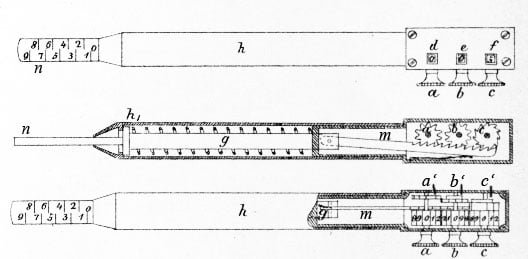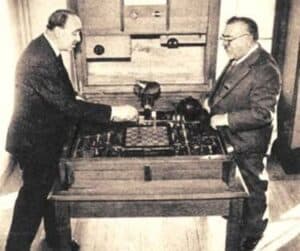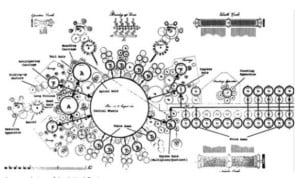Born in the city of Dresden, Sachsen, Deutschland on September 14, 1845, Friedrich Oskar Leuner was born to Carl Moritz Leuner and Christiane Wilhelmine Warzel. However, he simply went by Oskar Leuner throughout his life. Leuner was a mechanical engineer and established his own workshop in 1870. His workshop mostly made technical and scientific instruments for Dresden Polytechnic College. Eventually, the workshop became the Mechanische Institut of Oskar Leuner an der technischen Hochschule zu Dresden, or the Mechanical Institute of Oskar Leuner at the Technical University of Dresden.
Sometime during the 1870s, Leuner created a new calculating device that he called the Addirstift, or Adding Pencil. He married Johanne Marie Elisabeth Wackwitz, and died on October 3, 1930, in Dresden, Sachsen, Deutschland.
Quick Facts
- Full Name
- Friedrich Oskar Leuner
- Net Worth
- N/A
- Children
- N/A
- Nationality
- German
- Place of Birth
- Dresden, Germany
- Fields of Expertise
- [“Mathematics”,”Mechanical Engineering”]
- Institutions
- Dresden Polytechnic College (Technischen Hochschule), Mechanische Institut of Oskar Leuner an der technischen Hochschule zu Dresden (Mechanical Institute of Oskar Leuner at the Technical University of Dresden)
- Contributions
- Addirstift (adding pencil)
Oskar Leuner and the Addirstift
Before the calculating device became what it is today, the idea of an adding device was front and center on the minds of many of the world’s most intelligent thinkers. With so many different people running through a multitude of different ideas, it goes without saying that not everything stuck. Still, these innovations — whether failed or successful — all eventually led to the calculator as we know it today.
One such device that displayed ingenuity despite its eventual failure and one such inventor who wasn’t afraid to take a risk? The Addirstift from mechanical engineer Oskar Leuner. But who was Oskar Leuner, and what did he do in life that led to the invention of this adding device? Not to mention, what was his invention like? Let’s dive into the personal history of Oskar Leuner to find the answers to these questions and more.
Who Was Oskar Leuner?
Before getting into what mechanical engineer Oskar Leuner did, it’s worth discussing what his life was all about. This begins with his early life as a mechanical engineer in Dresden, Germany.
Early Life
Born in 1845 in Dresden, mechanical engineer Friedrich Oskar Leuner proves to be an elusive man whose early years have evaded the history books. Beyond the year and the place he was born, not much else is known about Leuner’s life before establishing a workshop in his hometown in 1870. While there’s very little to be said about his life prior, this moment was career-defining for Leuner.
Career
Leuner’s Dresden workshop focused primarily on the realm of scientific and technical instruments, specifically the areas of construction and manufacturing. After a handful of years working independently, the year 1876 saw Dresden Polytechnic College (also known as Technischen Hochschule) contracting Dresden to work for them. Years later, Leuner’s workshop transformed into the Mechanische Institut of Oskar Leuner an der technischen Hochschule zu Dresden. This roughly translates to the Mechanical Institute of Oskar Leuner at the Technical University of Dresden. This iteration of his workshop existed until Leuner’s death in 1930.

Leuner’s independent workshop became part of the Mechanical Institute of Oskar Leuner at the Technical University of Dresden from 1876 to 1930.
©xantolus/Shutterstock.com
What Did Oskar Leuner Do?
Before Leuner began working for the Dresden Polytechnic College or the Mechanische Institute, he was working on projects of his own accord. During this time, Leuner conceived and manufactured a small batch of an original calculating device he called the Addirstift, or the adding pencil. This calculating device was first patented in 1877 and resembled devices made by other contemporary thinkers like Charles Corliss and Marshall Smith.

Leuner’s adding pencil worked like this: Inside a cylindrical sleeve shaped like a pencil, a mounted steel axis was fixed to a thick pin with a round plate. The pin could be moved in or out of the top of the sleeve, stopping its reach when the round plate and pin reached their limit. The pin was inscribed with the digits 0 through 9 in equal intervals. It almost resembled a tire pressure meter, in a way. On the other end of the sleeve was a mounted square box with three buttons and a corresponding 10-teeth ratchet wheel for each. This was where the adding machine displayed the answers to its math equations. It was capable of reaching totals up to 999.
The Addirstift’s tens carry mechanism worked by mounting all three ratchet wheels on the same axes. Because the ones place unit wheel only had a single tooth, it could transfer the carry to the wheel in the tens place without impacting the other two wheels. This wheel was also coupled with another single-tooth wheel, it could then transfer the carry to the 10-teeth wheel in the hundreds place if need be. To reset the device to zero, users simply had to press all three buttons at once.

